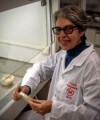Actualidad
Effects of Methyl Jasmonate on Pear During Low-Temperature Storage
Transcriptomic and metabolomic analyses indicate the role of methyl jasmonate as a means to alleviate harmful lignification in pears occurring at low temperatures during storage
Pear (Pyrus communis, Rosaceae family) is a fruit of significant economic importance worldwide. However, unlike apple and peach, pears contain stone cells in the pulp that can produce a rough texture, compromising their quality and diminishing consumer satisfaction.
These cells, developing from parenchyma cells, undergo programmed cell death, preceded by thickening of secondary cell walls with the accumulation of cellulose and lignin.
Lignin deposition leads to the hardening of the cell walls in the pericarp cells and affects sugar content as well as the storage capacity of the pear.
Temperature of Storage and Stone Cells
Pears are often harvested in mid-summer, and high temperatures quickly lead to deterioration as they are highly susceptible to mechanical damage and fungal infections.
Low-temperature storage is an effective method to extend the shelf life of pears, but it also promotes the formation of stone cells through a pathway involving reactive oxygen species (ROS) such as singlet oxygen (1O2), hydrogen peroxide, and OH•.
ROS and Lignin Formation
Lignin is a major component necessary for the formation of the secondary cell wall. Lignin biosynthesis precursors are derived from the phenylpropanoid metabolism, initiated by the enzyme L-phenylalanine ammonia-lyase, followed by several other enzymes where phenylalanine deamination to form cinnamic acid undergoes a series of hydroxylation, methylation, and reduction reactions, generating five major monomers for lignin biosynthesis.
These monomers further polymerize to form three types of structural units through a series of enzymatic reactions: syringyl lignin (S-lignin), guaiacyl lignin (G-lignin), and p-hydroxyphenyl lignin (H-lignin), connected by a variety of random bonds.
ROS are inevitably generated in plant redox reactions, including respiration and photosynthesis. They are mainly produced in chloroplasts, mitochondria, and peroxisomes, containing proteins or molecules with a sufficiently high redox potential to either excite or donate an electron to atmospheric oxygen.
Excessive ROS accumulation causes oxidative stress, including lipid peroxidation of the cell membrane, protein denaturation, pigment breakdown, and DNA damage. These stresses lead to irreversible cell damage, and even cell death.
Cell Systems to Eliminate ROS
Meanwhile, plant cells activate a series of enzymatic and non-enzymatic antioxidant mechanisms to eliminate excess oxidants and prevent harmful effects.
Enzymes such as superoxide dismutase, ascorbate peroxidase, catalase, peroxidase, and glutathione reductase constitute an efficient antioxidant system. However, some highly toxic reactive oxygen species (ROS), such as 1O2 and OH•, must be eliminated with the help of non-enzymatic antioxidant systems, including carotenoids, α-tocopherol, and polyphenols.
Methyl jasmonate is a vital phytohormone involved in various plant processes, including stress tolerance and crosstalk with other phytohormones. It induces the accumulation of secondary metabolites during oxidative stress in plant cells.
Methyl Jasmonate and Lignin Polymerization
Methyl jasmonate is a vital phytohormone involved in various plant processes, including stress tolerance and crosstalk with other phytohormones. It induces the accumulation of secondary metabolites during oxidative stress in plant cells.
Methyl jasmonate has been shown to have positive effects on increasing bioactive compounds in fruit with potential antioxidant properties when applied after or before harvest, presenting the potential to be a natural and eco-friendly option, positively modulating physiological processes to maintain postharvest fruit quality.
Methyl jasmonate inhibits lignin polymerization and aggregation. Postharvest application of methyl jasmonate has efficiently alleviated lignification and, in turn, reduced stone cell formation during low-temperature storage (4°C). The molecular mechanism of methyl jasmonate in regulating lignin biosynthesis was investigated through metabolic and transcriptomic analysis.
The application of methyl jasmonate inhibits lignin polymerization and aggregation by repressing the expression of genes encoding enzymes in the final stage of the lignin biosynthesis pathway. Additionally, it alleviates ROS-mediated lignification by promoting flavonoid accumulation.
On the other hand, the inhibition of the lignification process by methyl jasmonate probably depends on the activation of endogenous jasmonic acid biosynthesis and its signaling pathway.
Source
Hong, P.; Zhang, J.; Shi, D.; Yang, C.; Zeng, M.; Li, X.; Zhou, K.; Xi, W. (2024). Postharvest application of methyl jasmonate alleviates lignin accumulation in stone cells of pear fruit during low-temperature storage. Postharvest Biology and Technology, 209: 112692.
Image
Link to Image Accessed on 27/02/2024.













